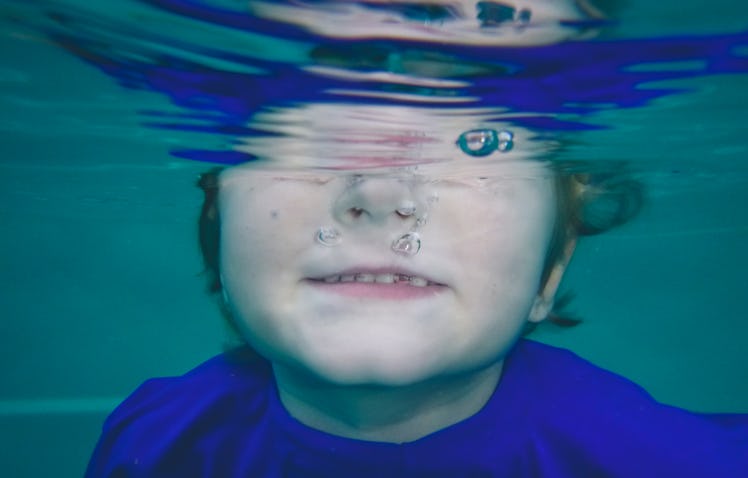How To Teach A Kid To Dunk Their Head Under Water
Fear of submerging the head or getting water on the face is often a learned behavior. Thankfully, it can be unlearned too.

Fear of water is common it kids, particularly when it comes to getting their head under water. And parents who feel the fear is irrational will likely be frustrated when they can’t can’t figure to dunk a child’s head in the bath to rinse out the shampoo. But, for kids, fearing the act of putting their face or head under water is completely rational, and there’s no threat or sharp remark a parent can say to change that.
There’s actually a strategic approach to a child’s fear of water that almost invariably works, says Carolanne Caron, a water safety expert who specializes in helping people with a fear of water. It starts in the tub, and it includes something many parents are already pretty good at: playing peek-a-boo.
“The child should be looking up to the ceiling when washing their hair so the soap doesn’t go into their eyes,” says Caron. “Work from the middle of the head up to the forehead with the clear water and don’t worry about it getting close to the eyes. If water does get by the eyes, don’t rub the eyes to clear but teach the child to blink their eyes three times slowly. I like to do this with scrunched eyes followed by wide eyes and ‘peek-a-boo.’”
Teaching the child to clear their eyes by blinking instead of rubbing is key. Pure water isn’t found in a pool or a lake — and if the bathwater is soapy, pure water isn’t in the tub either. Rubbing the eyes after water gets in them can make it worse. The blinking trick helps kids clear their eyes, or at least helps them think they do.
“The key is to teach the blinking trick — when water gets close to the eyes, blink three times slowly and then celebrate the accomplishment of getting the eyes wet,” explains Caron. “You should never force a child to dunk their head underwater. They will do it when they are ready.”
Older kids can benefit from wetting their head piece-by-piece during bath time. Pouring a cup of clear water over each part of the head can help a child get used to the sensation, starting with the shoulders and then moving to the cheeks, closed mouth, ears, nose, and scalp. In a pool, parents can pour water over their own shoulders, cheeks, and mouth as a way to build trust.
Once a kid is ready, there’s a number of games to play with a child to help them get comfortable under the water: Teaching them to blow bubbles or having them reach for small toy or rings in the pool. Such fun pastimes all encourage kids to submerge and give them something to focus on other than the new sensation of being underwater.
Confidence in the water isn’t the same as a skill; it only allows the skill to be developed. The kids still need to actually learn to swim. It’s still important to supervise while letting them explore — even good swimmers can get into trouble — and there’s other stuff to worry about in a pool. But parents shouldn’t worry too much. Kids can pick up on their parents’ uneasiness.
“Most of the time, the child is inadvertently taught to fear water from their parents,” explains Caron. “If the parent has a fear of the child being near the water, the child will develop that fear. So the parent needs to confront their fear so they don’t pass it along to the child.”
This article was originally published on